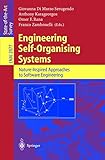Engineering Self-Organising Systems [electronic resource] : Nature-Inspired Approaches to Software Engineering /
Material type: TextSeries: Lecture Notes in Artificial Intelligence ; 2977Publisher: Berlin, Heidelberg : Springer Berlin Heidelberg : Imprint: Springer, 2004Edition: 1st ed. 2004Description: X, 212 p. online resourceContent type:
TextSeries: Lecture Notes in Artificial Intelligence ; 2977Publisher: Berlin, Heidelberg : Springer Berlin Heidelberg : Imprint: Springer, 2004Edition: 1st ed. 2004Description: X, 212 p. online resourceContent type: - text
- computer
- online resource
- 9783540247012
- 005.1 23
- QA76.758
Applications -- Self-Organisation: Paradigms and Applications -- Self-Organizing MANET Management -- Toward the Application of Self Organizing Systems to Agent Infrastructures – A Critical Review and Prospects -- Natural Metaphors -- A Catalog of Biologically-Inspired Primitives for Engineering Self-Organization -- Nature-Inspired Self-Organisation in Wireless Communications Networks -- Designing Self-Assembly for 2-Dimensional Building Blocks -- Strategies for the Increased Robustness of Ant-Based Clustering -- Self-Organising in Multi-agent Coordination and Control Using Stigmergy -- Managing Computer Networks Security through Self-Organization: A Complex System Perspective -- A Holonic Self-Organization Approach to the Design of Emergent e-Logistics Infrastructures -- An Evolutionary Approach for Studying Heterogeneous Strategies in Electronic Markets -- Artificial Interaction Mechanisms -- Self-Organizing Agents for Mechanical Design -- Can Tags Build Working Systems? From MABS to ESOA -- Self-Organizing Referral Networks: A Process View of Trust and Authority -- Middleware -- Adaptiveness in Linda-Based Coordination Models -- Self-Organization in Multi Agent Systems: A Middleware Approach -- Methods and Tools -- Providing Effective Access to Shared Resources: A COIN Approach -- A Modular Paradigm for Building Self-Organizing Peer-to-Peer Applications -- Tools for Self-Organizing Applications Engineering.
As information handling systems get more and more complex, it becomes increasingly difficult to manage them using traditional approaches based on centralized and pre-defined control mechanisms. Over recent years, there has been a significant increase in taking inspiration from biology, the physical world, chemistry, and social systems to more efficiently manage such systems - generally based on the concept of self-organisation; this gave rise to self-organising applications. This book constitutes a reference and starting point for establishing the field of engineering self-organising applications. It comprises revised and extended papers presented at the Engineering Self-Organising Applications Workshop, ESOA 2003, held at AAMAS 2003 in Melbourne, Australia, in July 2003 and selected invited papers from leading researchers in self-organisation. The book is organized in parts on applications, natural metaphors (multi-cells and genetic algorithms, stigmergy, and atoms and evolution), artificial interaction mechanisms, middleware, and methods and tools.


There are no comments on this title.